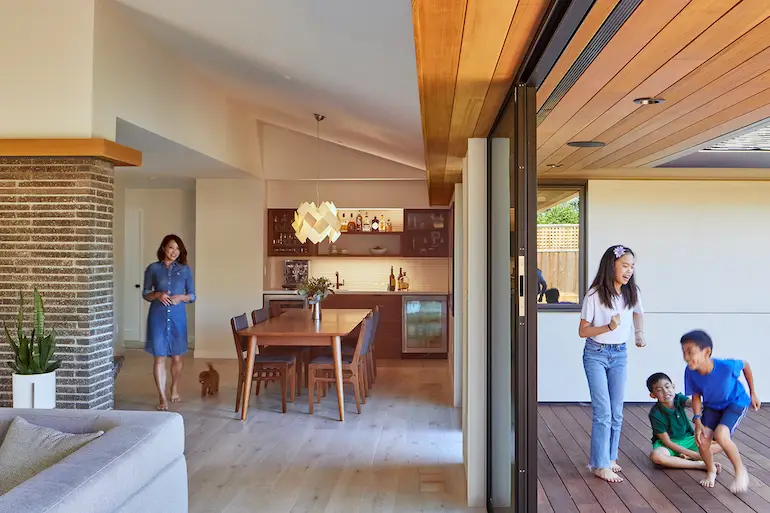When Lily and Alex Wang bought a 1950s ranch in near-original condition, they knew they were in for significant renovations. The layout wasn’t ideal for their family of 5 (plus a poodle puppy named Truffle), but they fell in love with the remnants of a Japanese garden—which also badly needed a refresh—that the L-shaped home wrapped around.
The couple also thought the Los Altos home’s midcentury modern aesthetic would pair well with their deep appreciation for Japanese design. Their vision was a seamless indoor-outdoor lifestyle with the restored garden as the centerpiece, along with modern-day functionality and maximum sustainability.

“We wanted a true sanctuary for relaxation and hosting,” Lily says.
They found just the team to make it happen in Palo Alto-based Ogawa Fisher Architects, who drew up a whole-house remodel and 3 additions.
A REVISED FLOOR PLAN

The original L-shaped floor plan was a maze of small spaces—typical of the era. The only room with an advantageous view of the garden was the living room, which took up most of one wing. 4 small bedrooms were packed into the other wing, and a narrow, windowless kitchen was tucked into the vertex.
OFA principal Hiromi Ogawa says, “Our concept was to surround the garden with public spaces where you spend most of your day.”
That meant flipping the bedrooms and kitchen, and adding a new primary suite with a private outdoor lounging area. A new attached garage was built on the street side.
The original detached garage became a one-bedroom guest suite with a kitchen and a bath. A wall of glass sliders opens the space, which doubles as Alex’s home office and guest quarters, to the tranquil garden.
The architects incorporated a number of sustainable features, including solar panels on the roof, a battery backup system and a charging station in the garage for the family’s electric vehicle.
THE ENGAWA

A key architectural element is the engawa, a wide wooden deck connected to the home and flush with the interior floor. The Wangs’ engawa runs in a U-shape along three sides of the garden: on both sides of the living room wing, and outside the primary suite.

Existing glass sliders were enlarged, and new ones were added to heighten the garden’s visibility from almost anywhere in the home. The roof’s overhangs were deepened and enclosed with tongue-and-groove cedar soffits to prevent unnecessary heat gain and glare from the sun.
“The walkway blurs the lines of inside and outside,” Ogawa says.
THE GARDEN

Restoring the Japanese garden to year-round glory was an organic process of trial and error. For guidance, the Wangs brought in a consultant from the century-old Hakone Estate and Gardens, a Japanese garden in Saratoga, California, that’s open to the public. Their plan incorporated natural elements of water, wood and rock with a single off-center cypress tree as the anchor.
The project entailed moving massive boulders—a few went to the front yard—and digging out overgrown foliage, including a second cypress tree. More rocks of varying sizes were added and organized in tiers to direct the flow of a streaming water feature. Alex even got a workout helping with the arrangement.
A selection of new botanicals that require minimal irrigation was strategically planted, and the side without the engawa was bordered with curvilinear bamboo fencing by the Elk Grove-based landscape design firm Stroke of Nature.
“It looks natural and authentic, and it’s very intentional,” Lily observes. “There was a lot of moving rocks back and forth until it looked finished.”
THE KITCHEN

The airy, open kitchen with a breakfast nook and an adjacent dining room was designed to entertain a crowd, whether guests mingle around the central island or wander onto the engawa. A mix of laminate and walnut cabinets, an engineered quartz counter and pendant globe lights are sleek and modern, nodding to the home’s midcentury origins.
“The kitchen has really big sliders, so it also becomes part of the courtyard,” Ogawa says.
THE FRONT ENTRANCE

The new garage and guest suite, at opposite ends of the front of the house, are joined by a small courtyard and a continuous roof. A cubic opening above lets light stream in. From this small courtyard, a gate leads to the engawa. The gate is reminiscent of shoji screens—the translucent, folding screens that are ubiquitous in Japanese interiors.

Japanese metal rain chains, which function as both downspouts and decorative water features, hang intermittently along the exterior of the house. The rain chains chime sweetly in the breeze.
A handful of boulders, relocated from the garden, artfully blend with drought-resistant landscaping in the front yard—a preview of what’s beyond the gate.
Working with principals Hiromi Ogawa and Lynn Fisher, OFA’s in-house interior designer Catherine Nelson, along with team members Sucharitha Yelimeli and Cristian Figueroa, selected most of the furnishings and art, incorporating them with pieces the family already owned.
“The whole design makes us feel very relaxed, so we can really enjoy each other,” Lily says. “You can tell Hiromi approached this project as if it was her own home.”
More from SPACES:
- Tour a Chicago Home That Goes All In on Richly Hued, Dramatic Touches
- This California Reiki Healer’s Home Is Designed for Wellness and Balancing Chakras
- Patterns and Statement Lighting Bring the Energy into This Sunny Family Home in Marin County
 Pamela Dittmer McKuen is an award-winning Chicago-based freelance features journalist who specializes in home, design and travel. She has dual passions for dark chocolate and cats.
Pamela Dittmer McKuen is an award-winning Chicago-based freelance features journalist who specializes in home, design and travel. She has dual passions for dark chocolate and cats.
